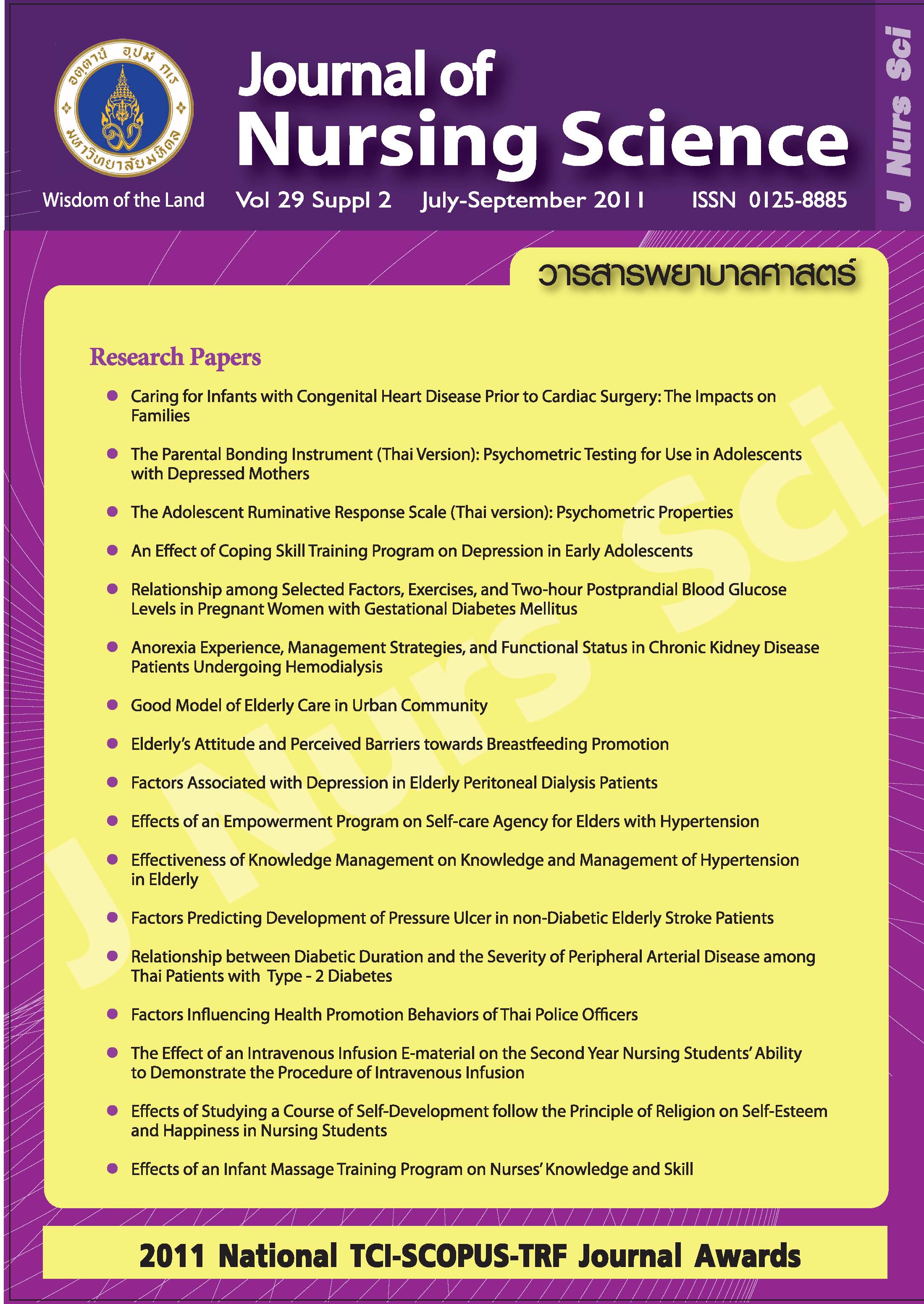The Adolescent Ruminative Response Scale (Thai version): Psychometric Properties
Main Article Content
Abstract
Purpose: This study aimed to evaluate the psychometricproperties of the Rumination Response Scale (RRS) in the Thaiyouths.
Design: A methodological research.
Methods: Following translation and cross-cultural adaptation, theRRS was tested on 1,417 adolescents aged ranging from 14 to 19years and attending the schools of Bangkok, Thailand. Data werecollected using a battery set of self-report questionnairesincluding the Thoughts, Feelings and Experiences Questionnaireand the Rumination Response Scale. The relationship ofrumination to emotional distress and suicide risk behaviors fortesting the construct validity was investigated. Confirmatoryfactor analysis and content validity index were performed tovalidate the factor structure and the content of the RRS. Inaddition, Cronbach’s alpha coefficient was calculated forreliability.
Main findings: The results revealed that the 3-factor structure ofthe RRS-Thai version fitted with the data well (χ2 = 0.094,df = 1, p = .759, GFI = 1.000, AGFI = 1.000, RMSEA = 0.000).The RRS-Thai version showed good content validity (CVI = .95)and internal consistency (α = .90). In addition, the ruminationwas also positively correlated with emotional distress (r = .736, p< .01) and suicide risk behaviors (r = .46, p < .01).
Conclusion and recommendations: The Rumination ResponseScale-Thai version showed satisfactory psychometric propertiesas to those of the original version and can be used for assessingThai adolescents at risk of suicide.
Article Details
Copyright Notice: Nursing Science Journal of Thailand has exclusive rights to publish and distribute the manuscript and all contents therein. Without the journal’s permission, the dissemination of the manuscript in another journal or online, and the reproduction of the manuscript for non-educational purpose are prohibited.

Disclaimer: The opinion expressed and figures provided in this journal, NSJT, are the sole responsibility of the authors. The editorial board bears no responsibility in this regard.
References
Vongsirimas N, Sitthimongkol Y, Beeber SL,Wiratchai N, Sangon S. Relationship among maternal depressive symptoms, gender differences and depressive symptoms in Thai adolescents. Thai J Nurs Res. 2009;13(3):181-98.
Boonyamalik P. Epidemiology of adolescent suicidal ideation: Roles of perceived life stress, depressive symptoms, and substance use (Dissertation). Baltimore (MD): Johns Hopkins University; 2005. 422 p.
Nintachan P. Resilience and risk taking behavior among Thai adolescents living in Bangkok. (Dissertation). Richmond: Virginia Commonwealth University; 2007. 329 p.
Garnefski N, Legerstee J, Kraaij V, Van den Kommer T, Teerds J. Cognitive coping strategies and symptoms of depression and anxiety: a comparison between adolescents and adults. J Adolescence. 2002; 25:603-11.
Smith MJ, Alloy BL, Abramson YL. Cognitive vulnerability to depression, rumination, hopelessness, and suicidal ideation: Multiple pathways to self-injurious thinking. Suicide Life-Threat. 2006 36(4):443-54.
Nolen-Hoeksema S. Responses to depression and their effects on the duration of depressive episodes. J Abnorm Psychol. 1991;100:569-82.
Nolen-Hoeksema S, Morrow J. A prospective study of depression and posttramatic stress symptoms after a natural disaster: The 1989 Loma Prieta earthquake. J Pers Soc Psychol. 1991;61:115-21.
Lam D, Schuck N, Smith N, Farmer A, Checkley, S. Response style, interpersonal difficulties and social functioning in major depressive disorder. J Affect Disorders. 2003; 75: 279-83.
Brislin RW. The wording and translation of research instrument. In W. J. Lonner & J. W. Berry, editors. Field methods in cross-cultural researc. Beverly Hills: Sage; 1986. P. 137-64.
Yu DF, Lee DT, Woo J. (2004). Issues and challenges of instrument translation. Wes J Nurs Res. 2004;26:307-20.
Thanoi W, Phancharoenworakul K, Thompson E, Panitrat R, Nityasuddhi D. Thai Adolescent Suicide Risk Behaviors: Testing a Model of Negative Life Events, Rumination, Emotional Distress, Resilience and Social Support. Pacific Rim Int J Nurs Res. 2010;14(3):187-202.
Hair FJ, Anderson RE, Tatham RL, Black WC. Multivariate data analysis. NJ: Prentice- Hall; 2006.
Hu LT, Bentler PM. Cutoff criteria for fit indexes in covariance structure analysis: Conventional criteria versus new alternatives. Struct Equ Modeling. 1999;6(1):1-55.
Sperber AD, Devellis RF, Boehlecke B. Cross-cultural translation: Methodology and validation. J Cross Cult Psychol. 1994;25(4):501-24.
Eggert LL, Herting JR, Thompson EA. High school questionnaire: Profile of experiences. Seattle: University of Washington School of Nursing; 1994.
Eggert LL, Thompson EA, Nicholas LJ, Herting JR. Measure of adolescent potential for suicide (MAPS): Measurement document. Seattle: University of Washington, Department of Psychosocial Nursing; 1999.
Waltz CF, Strickland OL, Lenz ER. Measurement in nursing and health research. 3rd ed. New York: Springer; 2005.
Burns N, Grove SK. Understanding nursing research. 4nded. Philadelphia: W.B. Saunders Company; 2001.
Just N, Alloy LB. The response styles theory of depression: tests and an extension of the theory. J of Abnorm Psychol. 1997;106:221-9.
Nunnally JC, Bernstein IN. Psychometric Theory, New York: McGraw-Hill. 1994.
Treynor W, Gonzalez R, Nolen-Hoeksema S. Rumination reconsidered: A psychometric analysis. Cognitive Ther Res. 2003;27:247–59.


